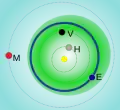5731 Zeus
| Discovery | |
|---|---|
| Discovered by | C. S. Shoemaker |
| Discovery site | Palomar Observatory |
| Discovery date | 4 November 1988 |
| Designations | |
| (5731) Zeus | |
| Pronunciation | /ˈzjuːs/[1] |
Named after | Zeus |
| 1988 VP4 | |
Apollo  | |
| Orbital characteristics[2] | |
| Epoch 13 January 2016 (JD 2457400.5) | |
| Uncertainty parameter 0 | |
| Observation arc | 9972 days (27.30 yr) |
| Aphelion | 3.742369097314678 AU (559.85044833175 Gm) |
| Perihelion | 0.7835569964232790 AU (117.21845823701 Gm) |
| 2.262963046869 AU (338.5344532844 Gm) | |
| Eccentricity | 0.6537473302944990 |
| 3.40 yr (1243.4 d) | |
| 322.1440564184060° | |
| 0° 17m 22.294s / day | |
| Inclination | 11.42805771205560° |
| 281.6911159636840° | |
| 217.0194868226350° | |
| Earth MOID | 0.0717527 AU (10.73405 Gm) |
| Physical characteristics | |
| 15.6 | |
5731 Zeus /ˈzjuːs/ is an Apollo asteroid and near-Earth object discovered on 4 November 1988, by Carolyn Shoemaker at Palomar Observatory. Based on its observed brightness and assumed albedo it is estimated to have a diameter between 2.1 and 4.7 km.[3] It is named after the Greek god of thunder and the sky, Zeus
References
- ^ "Zeus". Lexico UK English Dictionary. Oxford University Press. Archived from the original on 22 March 2020.
- ^ "5731 Zeus (1988 VP4)". JPL Small-Body Database. NASA/Jet Propulsion Laboratory. Retrieved 13 April 2016.
- ^ "5731 Zeus". European Asteroid Research Node. Archived from the original on 1 October 2010. Retrieved 30 March 2008.
External links
- 5731 Zeus at NeoDyS-2, Near Earth Objects—Dynamic Site
- 5731 Zeus at ESA–space situational awareness
- 5731 Zeus at the JPL Small-Body Database